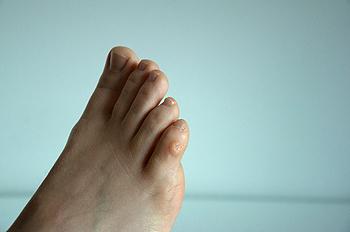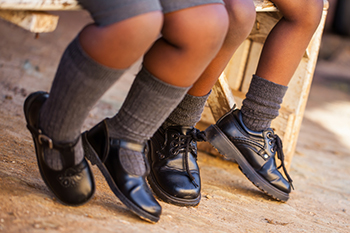Items filtered by date: December 2022
Three Types of Corns

A small, hardened area of skin that has formed on the foot may indicate a corn has developed. They generally develop on the outside of the pinky toe, or on the bottom of the foot, as a result of excessive friction. This can happen from wearing shoes and socks that are too tight, and temporary relief may come from choosing to wear shoes that fit correctly. A corn on the foot can cause severe pain and discomfort, despite their small size. There are three types of corns that can develop, consisting of hard, soft, and seed corns. The former is considered to be the most common type of corn, and can develop on top or on the side of the toes. Soft corns generally develop between the toes, as a result of excess moisture that can accumulate there. The latter forms on the soles of the feet, and are generally small in size. Research has shown the best method to prevent a corn from developing is by wearing shoes that are comfortable. This is generally successful in alleviating pressure against the toes. Many people who have developed corns seek the advice of a podiatrist who can effectively remove them, and offer additional prevention techniques.
If you have any concerns regarding your feet and ankles, contact Afsaneh Latifi, DPM of Lenox Hill Podiatry. Our doctor will treat your foot and ankle needs.
Corns: What Are They? and How Do You Get Rid of Them?
Corns can be described as areas of the skin that have thickened to the point of becoming painful or irritating. They are often layers and layers of the skin that have become dry and rough, and are normally smaller than calluses.
Ways to Prevent Corns
There are many ways to get rid of painful corns such as wearing:
- Well-fitting socks
- Comfortable shoes that are not tight around your foot
- Shoes that offer support
Treating Corns
Treatment of corns involves removing the dead skin that has built up in the specific area of the foot. Consult with Our doctor to determine the best treatment option for your case of corns.
If you have any questions please feel free to contact our office located in New York, NY . We offer the newest diagnostic and treatment technologies for all your foot and ankle needs.
Why Diabetics Have to Care for Their Feet

Individuals who suffer from diabetes often have to take extra special care of different parts of their body. This is because diabetes makes the human body suffer from nerve damage, among many different things. However, nerve damage in the feet is often one of the most serious effects of having diabetes. Due to the nerve damage in the feet, many diabetics might experience some loss of feeling in the feet. As a result, diabetics ought to take extra special care of their feet because this lack of feeling may result in unnoticed afflictions of the foot if not closely monitored. Diabetics can make a point of examining their feet to ensure that they are not missing any signs of a foot condition. For example, performing a simple foot examination can improve the extent to which an individual is monitoring and checking for signs of damage to their feet. If you suffer from diabetes, contact a podiatrist for help today.
Diabetic foot care is important in preventing foot ailments such as ulcers. If you are suffering from diabetes or have any other concerns about your feet, contact Afsaneh Latifi, DPM from Lenox Hill Podiatry. Our doctor can provide the care you need to keep you pain-free and on your feet.
Diabetic Foot Care
Diabetes affects millions of people every year. The condition can damage blood vessels in many parts of the body, especially the feet. Because of this, taking care of your feet is essential if you have diabetes, and having a podiatrist help monitor your foot health is highly recommended.
The Importance of Caring for Your Feet
- Routinely inspect your feet for bruises or sores.
- Wear socks that fit your feet comfortably.
- Wear comfortable shoes that provide adequate support.
Patients with diabetes should have their doctor monitor their blood levels, as blood sugar levels play such a huge role in diabetic care. Monitoring these levels on a regular basis is highly advised.
It is always best to inform your healthcare professional of any concerns you may have regarding your feet, especially for diabetic patients. Early treatment and routine foot examinations are keys to maintaining proper health, especially because severe complications can arise if proper treatment is not applied.
If you have any questions please feel free to contact our office located in New York, NY . We offer the newest diagnostic and treatment technologies for all your foot and ankle needs.
Choosing the Right Shoes for Your Child

Keeping children in shoes can be challenging because their feet grow so rapidly. Here are some tips for finding the right shoes for your child. Check their shoes regularly for worn areas, seams that are stretched, and toes that are worn out. These may be signs that their shoes need to be replaced. Have the child’s foot measured each time they try on shoes so that both the length and the width are taken into account. There should be about half an inch between the end of the shoe and the toes. Avoid buying shoes that are too big for the child as this can cause falls. The heel of the shoe should fit snugly, but not too tightly. For best results, avoid the idea of breaking in the shoes at home, and instead, make sure the shoe fits well at the store. Discourage your child from wearing shoes with higher heels, as this may affect the development of healthy feet and legs. Instead, go for shoes with flatter, textured soles that can keep them from slipping and falling. For more information on the best shoes for your child, please consult a podiatrist.
The health of a child’s feet is vital to their overall well-being. If you have any questions regarding foot health, contact Afsaneh Latifi, DPM of Lenox Hill Podiatry. Our doctor can provide the care you need to keep you pain-free and on your feet.
Tips for Keeping Children's Feet Healthy
- Make sure their shoes fit properly
- Look for any signs of in-toeing or out-toeing
- Check to see if they have Clubfoot (condition that affects your child’s foot and ankle, twisting the heel and toes inward) which is one of the most common nonmajor birth defects.
- Lightly cover your baby’s feet (Tight covers may keep your baby from moving their feet freely, and could prevent normal development)
- Allow your toddler to go shoeless (Shoes can be restricting for a young child’s foot)
- Cut toenails straight across to avoid ingrown toenails
- Keep your child’s foot clean and dry
- Cover cuts and scrapes. Wash any scratches with soap and water and cover them with a bandage until they’ve healed.
If you have any questions, please feel free to contact our office located in New York, NY . We offer the newest diagnostic and treatment technologies for all your foot care needs.
Why Live with Pain and Numbness in Your Feet?
Foot Melanomas

Skin cancer can present itself as tumors that grow in the skin. Melanoma is the most serious form of skin cancer and develops in the melanocytes, the cells that produce melanin or pigment that gives skin its color. Melanoma can spread to other parts of the body, so it is imperative that treatment is sought quickly. Such skin cancer can occur on the feet or toenails. Those with fair skin, who are sensitive to sunlight, have a history of severe sunburn before age 18, have pre-existing moles on their feet, have many moles on their bodies, and have a family history of skin cancer are more apt to develop foot melanomas. These melanomas are often overlooked because feet tend to be neglected and people do not examine them on a regular basis. If you have a suspicious mole on your foot that appears to have changed over time, especially if you are in a high-risk group, it is suggested you see a podiatrist as soon as possible to have it checked out.
Foot surgery is sometimes necessary to treat a foot ailment. To learn more, contact Afsaneh Latifi, DPM of Lenox Hill Podiatry. Our doctor will assist you with all of your foot and ankle needs.
When Is Surgery Necessary?
Foot and ankle surgery is generally reserved for cases in which less invasive, conservative procedures have failed to alleviate the problem. Some of the cases in which surgery may be necessary include:
- Removing foot deformities like bunions and bone spurs
- Severe arthritis that has caused bone issues
- Cosmetic reconstruction
What Types of Surgery Are There?
The type of surgery you receive will depend on the nature of the problem you have. Some of the possible surgeries include:
- Bunionectomy for painful bunions
- Surgical fusion for realignment of bones
- Neuropathy decompression surgery to treat nerve damage
Benefits of Surgery
Although surgery is usually a last resort, it can provide more complete pain relief compared to non-surgical methods and may allow you to finally resume full activity.
Surgical techniques have also become increasingly sophisticated. Techniques like endoscopic surgery allow for smaller incisions and faster recovery times.
If you have any questions please feel free to contact our office located in New York, NY . We offer the newest diagnostic and treatment technologies for all your foot and ankle needs.





